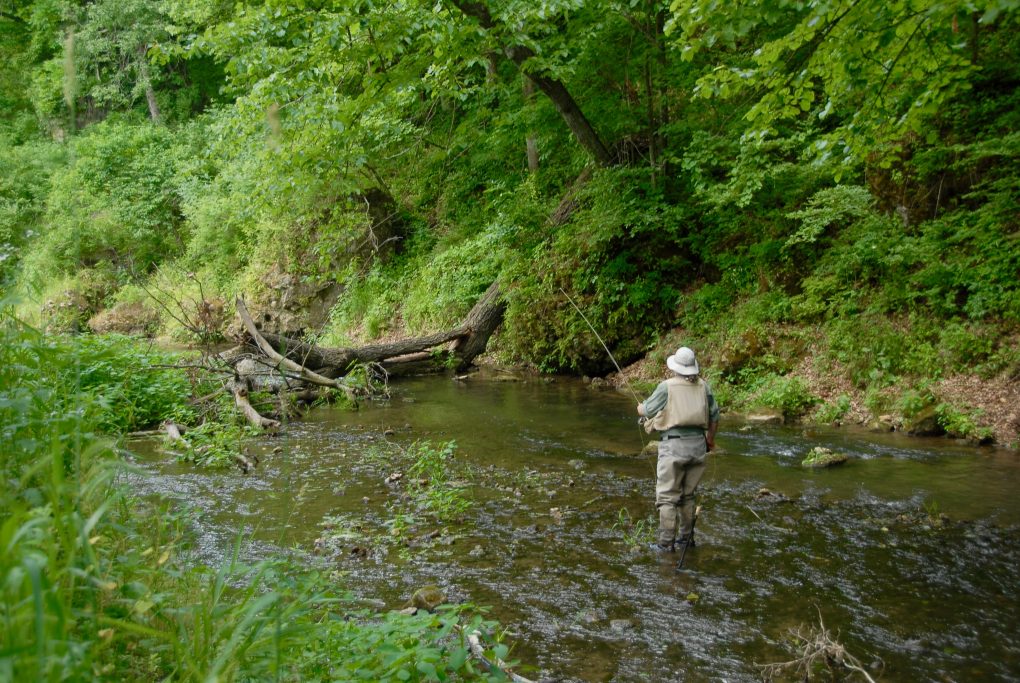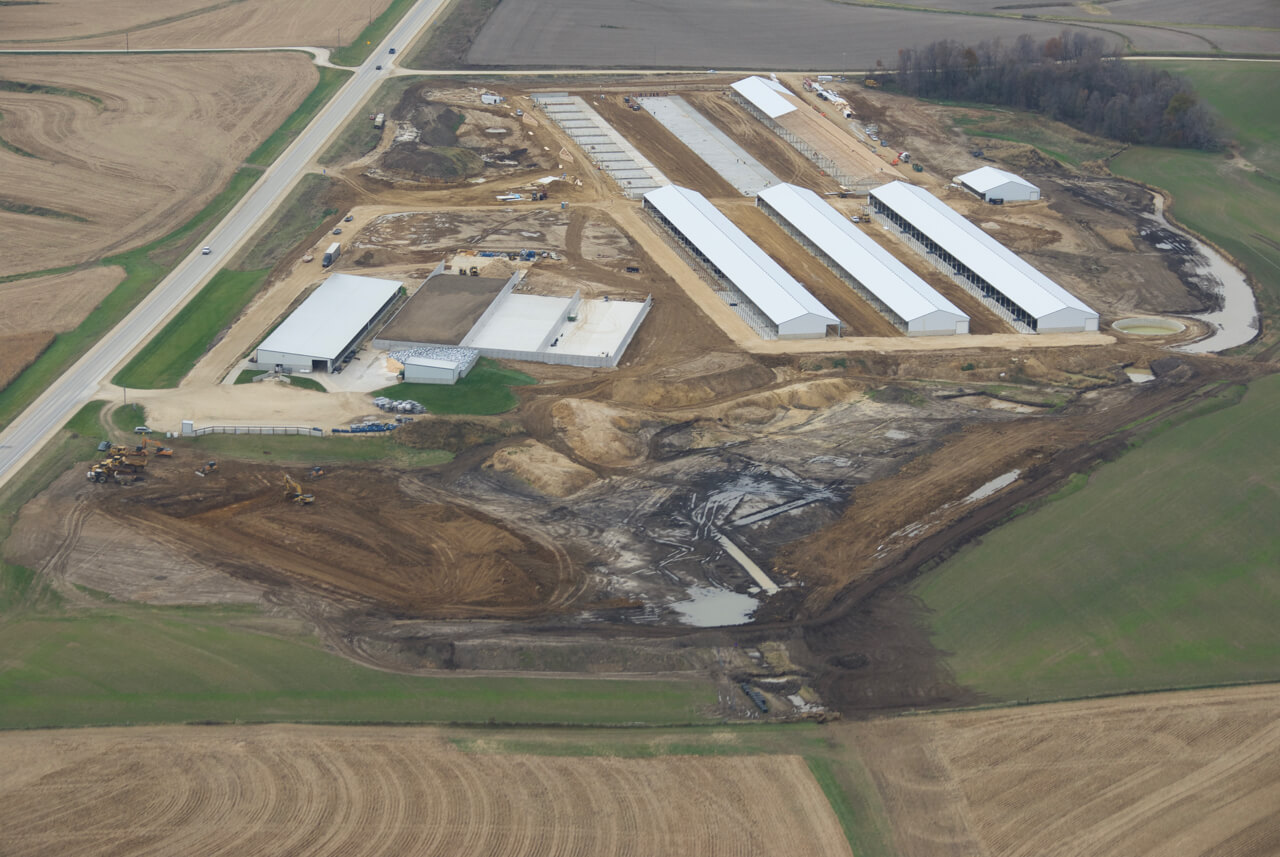Featured Communities – Bloody Run Creek, Iowa
This piece was written by Steve Veysey and Larry Stone of Save Bloody Run Creek.

Photo by David Thorenson.
Amidst the beauty of deep-cut limestone valleys, towering cliffs, subterranean caves, sinkholes, and cold-water springs, the karst region of NE Iowa, SE Minnesota, and SW Wisconsin is known far and wide as the Driftless Area. Bloody Run Creek, an Outstanding Iowa Water, runs into the Mississippi River at Marquette, Iowa, population 448. Sinkholes, often leading to underground caves and springs, form in the fractured and soluble limestone underneath shallow layers of till and are direct conduits for pollution to enter the aquifer within minutes.[1]
The “Committee to Save Bloody Run,” local community groups, and the Iowa Chapters of the Sierra Club and Trout Unlimited, are working together to protect this unique ecosystem from a new, 12,000-head cattle feedlot built in Bloody Run Creek’s headwaters.
The Problem
In 2017, Supreme Beef LLC, began construction of a concentrated animal feeding operation (CAFO). Six massive cattle barns have been built adjacent to five sinkholes. A lagoon, located in the middle of a FEMA floodway, was approved for the industrial effluent associated with a planned methane digester. When the digester plan was scrapped, however, the lagoon site became a 39-million gallon earthen manure basin. Under Iowa law, earthen manure basins are prohibited in karst terrain unless there is 25 feet of separation to the bedrock. Here, bedrock is less than 10 feet below the bottom of this basin.
The “nutrient management plan” (NMP) required for the operation projected spreading 30 million gallons of liquid manure per year on nearby fields in the watersheds of Bloody Run Creek and nearby streams at rates of 17,600 gallons per acre. Most of the fields are designated by NRCS as highly erodible land, sinkholes are everywhere, and glacial till topsoil is thin. The underlying fractured limestone and dolomite are direct conduits for pollution to move quickly from the surface to both shallow and eventually deeper aquifers. Iowa Department of Natural Resources’ (DNR’s) own studies list these aquifers as very vulnerable to surface pollution.
The collective protectors of Bloody Run Creek have challenged the stormwater permit, the nutrient management plan, NRCS conservation plan implementation, and the water withdrawal permit. In addition, they filed an Iowa Senate ethics complaint, and two court cases are pending.
The Clean Water Act (CWA) regulates point source pollution, yet in Iowa, most pollution is agricultural non-point source pollution which creates more hurdles in legally challenging water quality issues. This is why it is even more important that the CWA programs that apply to waters in agricultural areas, such as those relevant in Bloody Run Creek – water quality standards, antidegradation, CAFO NPDES permits, TMDLs, and construction stormwater permits – be properly implemented.
Overdue Designation of Uses
In 2002, the DNR revealed that 83% of the state’s river and stream miles were designated only for “general use” without any numerical water quality criteria. The 17% of streams with water quality criteria had been assigned “protected flows,” which meant the volume of water used in calculating NPDES point source permit dilutions was not always in the stream. For most of the first decade of the 2000s, a coalition of environmental advocacy groups led by the Iowa Chapter of the Sierra Club challenged EPA’s approval of these state’s water quality standards that did not meet the requirements of the CWA. The coalition prevailed, resulting in the presumption that all Iowa waters support aquatic life and recreational uses. Over a five-year period, every perennial river and stream segment was subjected to a scientific analysis called a Use Attainability Analysis (UAA) to confirm or rebut that presumption. In the waters that were confirmed to support aquatic life and recreation, hundreds of small municipalities and unsewered communities were required to upgrade their infrastructure, often to prevent direct discharges into agricultural tile lines. This significant achievement was heralded nationwide.
Establishment of Antidegradation Policy and Methods
At the same time, fishing groups in the coalition pushed for the establishment of Antidegradation Policies and Methods for “Outstanding Iowa Water” (Tier 2.5) and “Outstanding National Water” (Tier 3) categories that were totally absent from Iowa water quality standards. The result was a Tier 2.5 category with 31 stream segments and two lakes designated as “Outstanding Iowa Waters” for their exceptional recreational or ecological significance. Twenty-nine of those segments are trout streams located in the northeastern Iowa part of the Driftless Area, including Bloody Run Creek. Amidst a state with countless sediment-laden, nitrate-polluted, and bacteria-riddled streams, the coalition thought they had protected a few precious gems, but there was more to the story because the agriculture industry in Iowa wields extraordinary influence in the way the CWA is implemented and enforced.
TMDLs Lagging Behind
In the late 1990s, the Sierra Club successfully sued the state of Iowa for not enforcing TMDL requirements. Bloody Run Creek has been on Iowa’s impaired waters list for bacteria since 2010. Once a water body is listed, development of a TMDL is required. Unfortunately, there is no plan for a TMDL on Bloody Run Creek even with the Outstanding Iowa Waters designation. Approximately half of the Outstanding Iowa Waters are on the current impaired waters list, and no TMDLs have been completed. Iowa’s 2019 Long-Term Vision document states:
“The Iowa DNR will investigate the feasibility of protection TMDLs for the state’s Outstanding Iowa Waters. At this time, Iowa DNR is not ready to commit to developing a protection TMDL but will consider it in the future.”[2]
CAFO NPDES Permit Loophole
The CWA requires CAFOs the size of Supreme Beef LLC to obtain a NPDES permit, but many states have created a process for CAFOs to avoid the permit or minimize its requirements by demonstrating that they will not discharge to surface waters from the facility or the manure application fields. To be exempted from the permit requirements in Iowa, a CAFO only needs to state that they will not discharge. Supreme Beef LLC has made that claim. Manure from the 12,000 head of cattle contained in six 200-yard-long barns, totaling 30 million gallons every year, all of which must be disposed of in nearby watersheds, is not subject to an NPDES permit. From the perspective of the CWA, there is nothing for Save Bloody Run Creek and their partners to challenge.

Photo by Larry Stone.
If a CAFO without a permit discharges, the door opens for citizen lawsuits under the CWA. Save Bloody Run Creek is currently on that path with Supreme Beef LLC. Runoff samples collected after rain events in fall 2021 were professionally analyzed, revealing elevated ammonia and E. coli numbers in the thousands, well above the state water quality criteria. These results are a clear indication of manure discharges. A complaint filed with the DNR was rejected because,
“The DNR does not issue Notices of Violation or take enforcement actions based on third party sample results.”[3]
DNR disputed whether the bacteria came from the Supreme Beef CAFO. Volunteers will continue to monitor downstream of the facility until the body of evidence is irrefutable and a lawsuit can be filed.
The following public review and enforcement avenues have been pursued to date:
Construction Stormwater NPDES Permit
In 2017, Save Bloody Run Creek engaged in the public discussion of the NPDES construction stormwater permit requested by Walz Energy LLC (now Supreme Beef LLC). Hundreds of people were mobilized to attend the public hearing and submit passionate comments about the exquisite nature and value of Bloody Run Creek, and the harm that would be done by permitting the construction of the facility. The former State Geologist of Iowa explained the potential catastrophic consequences of manure pollution draining into the groundwater aquifer, given the known possibility that a sinkhole might open under the 39-million-gallon earthen basin in the karst terrain.[4] This concern was deemed irrelevant to the permit proceedings because the risk did not relate directly to the construction activities under review. Unfortunately, since the DNR claimed that the construction stormwater permit would only allow “temporary and limited degradation,” the public opposition, the Outstanding Iowa Water status, and the inevitable risks were dismissed. During construction, the DNR cited the owners with nine violations, several of which directly impacted Bloody Run Creek.
Nutrient Management Plan – Administrative Procedures Act Challenge
Although Supreme Beef LLC was able to avoid the CAFO NPDES permit, a state-approved nutrient management plan (NMP) was still required because the operation would house more than 1,000 cattle. Under Iowa rules, manure from large animal feeding operations (AFOs) must be applied at agronomic rates based upon the estimated crop uptake of nitrogen and phosphorus. The plan must identify enough field-acres available to accept the annual projected amount of nitrogen and phosphorus in the manure. Over the course of eight months, three versions of Supreme Beef LLC’s NMP were submitted due to errors, omissions, and incorrect calculations. Save Bloody Run Creek believes the final plan, approved in April of 2021, is still flawed in its calculation of the nutrient content of the manure. Consequently, the plan grossly underestimates the number of field-acres needed for manure application without resulting in water quality problems. Save Bloody Run is challenging the NMP under the state’s Administrative Procedures Act, claiming that DNR’s approval of the plan was arbitrary and capricious.
The coalition’s additional strategies include challenging the state water withdrawal permit and filing a whistleblower complaint about USDA payments received without an approved Conservation Compliance plan.
Conclusions and Takeaways
Bloody Run Creek is a special jewel deserving of extra protection, and it is CWA-designated as such. In Iowa the demands of industrialized agriculture have overshadowed the highly publicized and years-long struggle to protect this little stream. The shortcomings of state rules, implementation, and enforcement have been exposed, including the CWA programs run by the state such as the water quality standards, CAFO NPDES, and TMDL programs. Even working other laws and legal strategies, the siloed nature of the state agencies and protections of big agricultural interests have made it very difficult to move the needle on point or nonpoint source impairments in Iowa.
However, there is always hope. Thousands of individuals in Iowa have engaged or supported the Save Bloody Run Creek efforts. As was the case during their campaign 20 years ago to designate water uses and implement antidegradation, it seems they are making hidden progress. The glass is half full, even if the water in it is still dirty.
Footnotes
[1] Iowa Geological Survey, Living In Karst, Guidebook Series No. 25, 2005.
[2] Long-Term Vision for Assessment, Restoration, and Protection under the Clean Water Act Section 303(d) Program Updated: September 2019
[3] Iowa Department of Natural Resources Response to Complaint ID#30314, December 20, 2021.
[4] Iowa Geological Survey, Living In Karst, Guidebook Series No. 25, 2005, p.42; Robert D. Libra,State Geologist of Iowa, retired, Review of the Geology and Proposed Earthen Waste Lagoon near Monona IA, November 27, 2017.




